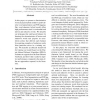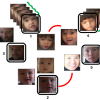603 search results - page 71 / 121 » A discriminative model for semi-supervised learning |
NAACL
2003
13 years 10 months ago
2003
In this work, we present a new semantic language modeling approach to model news stories in the Topic Detection and Tracking (TDT) task. In the new approach, we build a unigram la...
ACL
2009
13 years 6 months ago
2009
In this paper, we present a discriminative word-character hybrid model for joint Chinese word segmentation and POS tagging. Our word-character hybrid model offers high performance...
NIPS
1998
13 years 10 months ago
1998
Fraud causes substantial losses to telecommunication carriers. Detection systems which automatically detect illegal use of the network can be used to alleviate the problem. Previo...
EMNLP
2007
13 years 10 months ago
2007
This paper presents a syntax-driven approach to question answering, specifically the answer-sentence selection problem for short-answer questions. Rather than using syntactic fea...
ICCV
2009
IEEE
15 years 1 months ago
2009
IEEE
We introduce an algorithm that guides the user to tag
faces in the best possible order during a face recognition assisted
tagging scenario. In particular, we extend the active
l...


